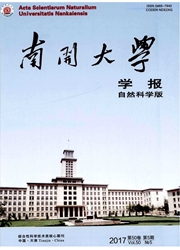

 中文摘要:
中文摘要:
探讨雄性大鼠吸人纳米二氧化钛(nano—TiO2)对其肝脏和肺脏的氧化损伤.32只雄性SD大鼠按体重随机分为4组,分别为0.8mg/mL纳米TiO2组、4mg/mL纳米TiO2组、20mg/mL纳米TiO2组纳米、对照组(生理盐水).各组大鼠一次性经呼吸道灌注纳米TiO2粒子悬液.7d后处死各组动物组,分别取肝、肺匀浆后用于测定SOD、GSH—Px活性及羟脯胺酸和MDA含量.肺组织匀浆的各指标中,高、中剂量纳米TiO2组MDA含量较对照组明显升高(P〈0.05),且羟脯氨酸较对照组明显降低(P〈0.05).肝组织匀浆的各个指标中,高剂量纳米TiO2组SOD活力较对照组明显降低(P〈0.05),高、中、低剂量纳米TiO2组GSH—Px活力与对照组相比均明显降低(P〈0.05),各剂量组MDA活力与对照组差异无显著性(P〈0.05).纳米二氧化钛致氧化损伤作用在肝、肺组织有不同表现,使肝脏清除氧自由基的能力减弱,使大鼠肺组织内脂质过氧化作用增强,并且使肺组织出现了早期纤维化的表现.
 英文摘要:
英文摘要:
To investigate the effects of the oxidative damages of their livers and lungs by inhalation of nano-TiO2 in male rats, 32 male SD rats were randomly divided into 4 groups by weight, nano-TiO2 group (0.8, 4, 20 mg/mL respectively) and the control group (physiological saline). Rats in each group were perfused with nano-TiO2 particle suspension once via respiratory tract. All animal groups were executed after a period of 7 days, taking liver and lung homogenates respectively for the purpose of measuring SOD, GSH-Px activity and hydroxyproline, MDA content. In all indices of the lung homogenate, medium, high-dose nano-TiO2 group's MDA content significantly rised compared to the control group (P〈0.05), hydroxyproline significantly fell compared to the control group (P〈0.05). The differences of each nano-TiO2 dose group SOD and GSH-Px activity with the control group have no statistical meaning (P〈0, 05). In all indices of the liver homogenate, high-dose nano-TiO2 group's SOD activity significantly fell compared to the control group (P〈0.05), high, medium, low-dose nano-TiO2 group GSH-Px activity all significantly fell compared to the control group (P〈 0.05), the differences of each dose group's MDA activity with the control group have no sig- nificance (P〈0.05). The oxidative damages brought by the nano-TiO2's effect have different forms in liver and lung which makes the liver's ability to eliminate oxygen free radicals weaker, makes the lipid peroxidation effects in the rats' lung stronger and makes the lung has appearance of early stage fibrosis.
 同期刊论文项目
同期刊论文项目
 同项目期刊论文
同项目期刊论文
 期刊信息
期刊信息
